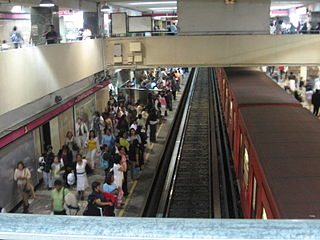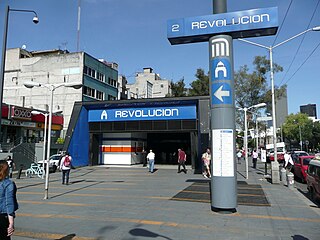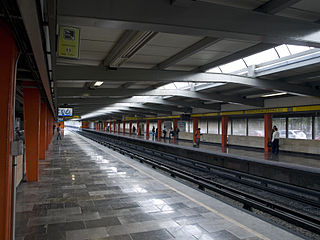
Cuatro Caminos is a station of the Mexico City metro network. Colloquially known as "Metro Toreo", it is the current north terminus of Line 2. The adjacent Mexipuerto Cementos Fortaleza Cuatro Caminos mixed-use development opened in 2016 and houses, besides a shopping center, residential tower and sports facility, a bus terminal that is a hub for regional bus and minibus transport from and into the State of Mexico. In 2019, the station had an average ridership of 114,947 passengers per day, making it the third busiest station in the network.

San Lázaro is a station on the Mexico City Metro. It is located in the Venustiano Carranza borough of Mexico City. It lies along Lines 1 and B. The station was opened on 5 September 1969. The station was designed by Félix Candela and consists of interlocked hyperbolic paraboloidal or saddle roof sections. From July 2022 to October 2023, the Line 1 station was closed due to modernization works on the tunnel and the line's technical equipment.

Buenavista is a station on the Mexico City Metro, in the Colonia Buenavista neighborhood of the Cuauhtémoc borough. It is the southwestern terminal station of Line B. It also offers connections to the Insurgentes Metrobús bus rapid transit line. In 2019, the station had an average ridership of 66,804 passengers per day, making it the tenth busiest station in the network.

Tasqueña is a station on Line 2 of the Mexico City Metro system. It is located in the Campestre Churubusco neighborhood, within the Coyoacán borough of Mexico City, directly south of the city centre on Avenida Tasqueña and Canal de Miramontes. It is a surface station and the southern terminus of the line. In 2019, the station had an average ridership of 83,463 passengers per day, making it the seventh busiest station in the network.

El Rosario is an at-grade station on the Mexico City Metro. It is located in Azcapotzalco borough, in the northern reaches of Mexico City. It serves as the terminal for both Lines 6 and 7.

Pino Suárez is a station on Line 1 and Line 2 of the Mexico City Metro system. It is located in the Cuauhtémoc borough of Mexico City, on the southern part of the city center. From July 2022 to October 2023, the Line 1 station was closed due to modernization works on the tunnel and the line's technical equipment.

Martín Carrera is a station on the Mexico City Metro. It is located at the borders of the Colonia Martín Carrera, Colonia 15 de Agosto, and Colonia Díaz Mirón districts in the Gustavo A. Madero borough, in the north of Mexico City. The station logo depicts bust of General Martín Carrera, a national hero who fought in the Mexican–American War of 1846–48.

Universidad is a station on the Mexico City Metro. It is located in the southern reaches of Mexico City, in Coyoacán borough. A surface station, it is the current terminus of Line 3. The station was opened on 30 August 1983. In 2021, the station had an average ridership of 25,858 passengers per day, making it the fifteenth busiest station in the network.

Chapultepec is a station on the Mexico City Metro. It is located in the Cuauhtémoc borough in the center of Mexico City. In 2019, the station had an average ridership of 57,873 passengers per day, making it the 14th busiest station in the network. Since 9 November 2023, the station has remained closed for modernization work on the tunnel and the line's technical equipment.

Tacubaya is a station on Lines 1, 7 and 9 of the Mexico City Metro system. It is located in the Miguel Hidalgo borough, west of the city centre. In 2019, the station had a total average ridership of 85,800 passengers per day, making it the fifth busiest station in the network. Since 9 November 2023, the Line 1 station has remained closed for modernization work on the tunnel and the line's technical equipment.

Tacuba is a station of the Mexico City Metro. It is located in the Tacuba district of the Miguel Hidalgo borough, to the west of downtown Mexico City. It lies along Lines 2 and 7.

Miguel Ángel de Quevedo is a station along Line 3 of the Mexico City Metro. It is located in Mexico City's southern Coyoacán borough, at the junction of Avenida Miguel Ángel de Quevedo and Avenida Universidad.

Revolución is a station on Line 2 of the Mexico City Metro system. It is located in the Colonia Tabacalera and Colonia Buenavista districts in the Cuauhtémoc borough of Mexico City, northwest of the city centre, on Avenida México - Tenochtitlan. It was first opened to the public on 14 September 1970.

Viveros / Derechos Humanos is a metro station along Line 3 of the Mexico City Metro. It is located between the Álvaro Obregón and Coyoacán boroughs of Mexico City.

Morelos is a station on the Mexico City Metro. It is located in Venustiano Carranza borough, in the north of Mexico City.

Politécnico metro station is a Mexico City Metro station in Gustavo A. Madero, Mexico City. It is an at-grade station with two side platforms that serves as the northern terminus of Line 5. It is followed by Instituto del Petróleo station. Politécnico station serves the colonias (neighborhoods) of Industrial Vallejo and Nueva Industrial Vallejo. The station's pictogram features the logo of the National Polytechnic Institute (IPN), a public university in Mexico City, and its name is on account of its proximity to the main campus.

Line 5, also known as the Yellow Line from its color on the system map, is a rapid transit line of the Mexico City Metro network. It travels 15.6 kilometers (9.7 mi) along the boroughs of Gustavo A. Madero, Cuauhtémoc and Venustiano Carranza in northern, northeastern and eastern Mexico City, serving thirteen stations. The line was inaugurated on 19 December 1981, going from Pantitlán to Consulado station. In 1982, the line was expanded twice, first from Consulado to La Raza station on 1 July, and later from La Raza to Politécnico station on 30 August.
The abbreviation TCUL stands for

Mexico City Metro Line 4 is the fourth line of Mexico City Metro. The line color is aqua blue and it runs from north to south of the city crossing the city center by its easternmost area. In 2019 it had a total ridership of 29,013,032 passengers, making it the least used line on the system.

Line 12, also known as the Golden Line from its color on the system map, is a partially closed rapid transit line of the Mexico City Metro network. It travels 25.1 kilometers (15.6 mi) along the boroughs of Benito Juárez, Iztapalapa and Tláhuac in southwestern, central-southern and southeastern Mexico City, serving twenty stations. The line was inaugurated on 30 October 2012, going from Tláhuac to Mixcoac station. In 2016, work to expand it to Observatorio station started. All the stations are accessible to people with disabilities as they have elevators, tactile pavings and braille signage plates.




















